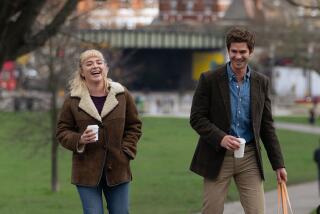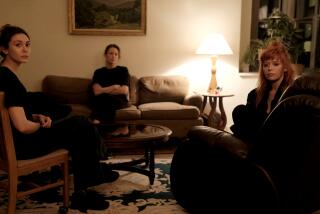Movie review: Lars von Trierâs âMelancholiaâ is â gasp â hopeful
How does the world end? When it is in the hands of the cinematic master of human misery, dark Danish auteur Lars von Trier, as it is in âMelancholia,â it ends in extraordinary, horrific, searing, aching and unthinkable ways. It is his most hopeful film yet.
Still firmly rooted in the filmmakerâs esoteric, frustrating, provoking, demanding narrative style, the movie is also amazingly romantic â lush, ripe, rich, delicious. Its apocalyptic vision is encouraging in its hopelessness; its star, Kirsten Dunst, luminous in her anguish and devastation. Excessive in every way, and yet restrained. Everything and nothing that youâd expect a film called âMelancholiaâ to be.
It is certainly the directorâs most beautiful film. And strangely, his most forgiving. I say strangely because the writer-director has proved not to be the forgiving sort, a sentiment that was cemented in 1996âs âBreaking the Wavesâ and crescendoed to grotesquely gothic extremes in his previous film, 2009âs âAntichrist.â
As Von Trier often does, he begins âMelancholiaâ by foreshadowing. In this case, he uses a series of seemingly random moments, images floating across the screen in stream-of-consciousness style, moments that heâll expand on, if not explain, later.
Itâs just enough to tantalize, to suggest that something wicked this way comes. There is a gracefully aging estate sitting above an ocean. There is an expansive and precisely manicured lawn, a sundial, a wide swath of fairway, yes, as in golf, in between. Shots of Dunst show flashes of agony and ecstasy. A full moon â or is it? â is rising. A desperate woman is running with her child. Chaos. Calm.
Stage set, he opens part one of this prophetic story of two sisters â Justine and Claire â with the younger. The just married and still in wedding white Justine (Dunst) is with her new husband Michael (Alexander Skarsgard) in the back of a limo that is trying, with little success, to make a very tight turn on a very narrow lane on the way to their reception. She is literally glowing, the coupleâs happiness is infectious and itâs impossible not to be seduced into sharing their joy.
As they try to navigate the turn that will take them to the estate where her sister Claire (Charlotte Gainsbourg) and husband John (Kiefer Sutherland) are hosting the reception, the film is playful, funny, feathery light.
But that lightness doesnât linger, and that nearly impassable spot is only the first, and the least important, of the many that are to come. As the reception unfolds in all the traditional ways â the toasts, first dance, cake cutting, throwing the bouquet â Justine begins to disappear. To slip inside the melancholia that she hoped the ritual of the wedding, the marriage would keep at bay.
Within that reception, Von Trier has created a stunning treatise on family, relationships, expectations, tradition and depression that is as rich and layered as the towering wedding cake that Claire and John try to coax Justine into cutting. Every scene becomes an exquisitely pained tug of war with nearly everyone at some point trying to pull Justine toward love and laughter and life, while she edges away. âDo you know how much this is costing?â John asks again and again. Whatever the figure, we know it is costing Justine far more.
This is where you begin to see why Dunst is getting the well-deserved raves for her performance, one that will no doubt earn her an Oscar nomination if not a win. It is quite extraordinary to see the life literally being extinguished in her eyes, even when the face is still doing its best to smile. Witnessing her emotional demons take hold, her descent into the tortured grip of depression, is as breathtaking as it is heartbreaking. Never has the actress been more naked, more emotionally exposed.
On that night, Justine spots a new star in the sky. It turns out to be a planet named Melancholia, many times the size of Earth and seemingly headed on a collision course for our world. And now Von Trier is ready to get serious about the end of days.
The second half of the film is given over to Claire, who takes in Justine and cares for her sister â or, rather, the shell that remains of the young woman, who was been swallowed up by her despair. Von Trier has long wrestled with depression himself, which makes the film from this always personal filmmaker feel even more intimate. Again Dunst proves riveting as an agonized human barely able to move, her emotional death creeping ever closer.
As Claire tries to nurture Justine back into life, the end of the world is turning into a real possibility and Von Trier ponders how people cope. The most rational are the most at risk, of course. John, played with impatient grace by Sutherland, becomes obsessed with watching and recording Melancholiaâs advance, turning it into a game to be played with his young son Leo (Cameron Spurr).
Gainsbourg can always be counted on to give over her interior life on screen, and she does so here, playing the older sister gently, lovingly. There are delicious turns by minor players; especially delightful is Udo Kier as the increasingly frustrated wedding planner and John Hurt as the sistersâ hopelessly romantic father.
The production itself is so sumptuous itâs sometimes easy to forget that this is Von Trier. Director of photography Manuel Alberto Claro (âReconstructionâ) proves masterful moving between claustrophobic interiors and wide-open exteriors. Individual scenes emerge like portraiture of the most exceptional sort. A scene of Claire trying to help Justine into a bath, shot through a half-open door, literally takes your breath away. The filmâs finale is wondrously indescribable. And costume designer Manon Rasmussen, a longtime Von Trier collaborator, should be in line for an Oscar nomination for Justineâs wedding dress alone.
Somehow the notion of examining depression and the apocalypse has freed the filmmaker, who tends to be most comfortable in the nether world of extreme dysfunction and all the ways we humans slowly torture one another toward miserable ends. In allowing himself to play, and I literally mean play, with the idea that the end is absolute, that life as we know it might disappear, he has found room to allow his characters to breathe in ways we have never seen in his work.
It is a lighter Von Trier, a lovely Von Trier, a seriously romantic Von Trier that emerges from âMelancholia,â and I quite hope he stays around.
More to Read
Only good movies
Get the Indie Focus newsletter, Mark Olsen's weekly guide to the world of cinema.
You may occasionally receive promotional content from the Los Angeles Times.











